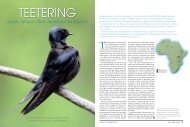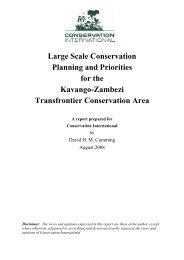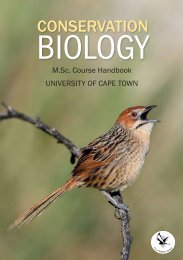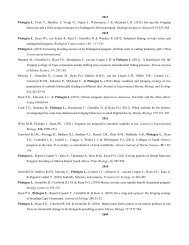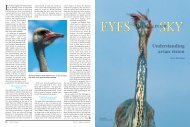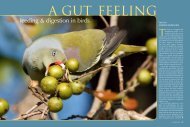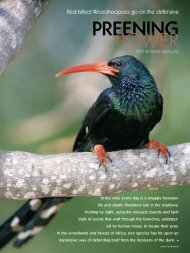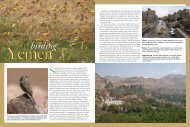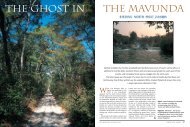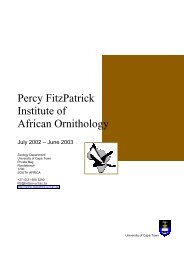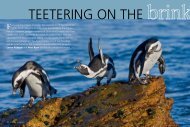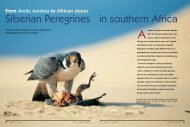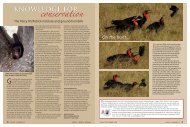Frigatebirds: aerial attitude.
Frigatebirds: aerial attitude.
Frigatebirds: aerial attitude.
You also want an ePaper? Increase the reach of your titles
YUMPU automatically turns print PDFs into web optimized ePapers that Google loves.
<strong>Frigatebirds</strong><br />
Opposite <strong>Frigatebirds</strong> live hard and<br />
play hard, are powerful and aggressive<br />
predators, yet so light and manoeuvrable<br />
that they can pick a twig off the surface<br />
Aerial<br />
Attitude<br />
Text and photographs by Ross Wanless<br />
The size of an albatross; the grace<br />
of a tern; the belligerence of a<br />
skua; the speed of a swift; the<br />
agility of a flycatcher and the<br />
<strong>attitude</strong> of... well, a frigatebird. These<br />
amazing seabirds are the undisputed, if<br />
somewhat despotic kings of the world’s<br />
tropical oceans.<br />
<strong>Frigatebirds</strong> are impressive creatures by<br />
whatever yardstick one chooses to measure<br />
them. They are highly specialised<br />
seabirds, completely in tune with their<br />
environment. So well adapted, in fact,<br />
that they have pared down to the absolute<br />
minimum anything not essential to<br />
their mode of living. Those features that<br />
are essential they have souped up to the<br />
extremes that drag-racing enthusiasts<br />
would appreciate.<br />
Their fame is widespread, well deserved,<br />
and comes for several reasons. Perhaps<br />
the most obvious trait is their well-known<br />
habit of attacking other seabirds, which<br />
they do ostensibly to get a free lunch.<br />
Basically, they are the biggest and meanest<br />
kids on the block: they pick on other<br />
birds, bullying and harassing them until<br />
they cough up lunch money. Seabirds<br />
returning to roost generally have a full<br />
crop of fish and frigatebirds are wont to<br />
patrol the flyways, picking off hapless<br />
victims as they return for the night. Once<br />
they have selected a victim, as many as<br />
five to 10 frigatebirds will give chase.<br />
They pull on the victim’s tail feathers,<br />
bite its legs, drag it by a wing-tip and even<br />
stick their bills down the other bird’s gullet<br />
to grab fish. Birds that choose to resist<br />
can suffer lethal consequences, such as<br />
broken wings or becoming completely<br />
exhausted. Often the victim will regurgitate<br />
some of its crop contents, and the<br />
frigatebirds will then dive and chase the<br />
ill-gotten gains. But they must catch it<br />
before it hits the water and sinks, for<br />
ironically frigatebirds, despite being seabirds,<br />
have no waterproofing. If they land<br />
in the sea, they drown.<br />
For a seabird not to have waterproof<br />
feathers sounds absurd, but frigatebirds<br />
have achieved this. It is questionable<br />
whether or not the ancestors of frigatebirds<br />
ever had waterproofing, but it seems<br />
probable that they did. Somewhere along<br />
their evolutionary path they became so<br />
proficient at catching food in mid-air that<br />
they did away with their waterproofing.<br />
It is a popular myth that frigatebirds are<br />
obligate klepto-parasites (in other words,<br />
that they derive a living from pirating<br />
of the ocean. <br />
36 frigatebirds<br />
africa – birds & birding
When a male frigatebird is not displaying,<br />
his gular pouch is visible only as a<br />
relatively small flap of skin on his throat.<br />
other seabirds’ food). This is<br />
clearly not the case: if nothing<br />
else, simple mathematics<br />
tells us so. For example, on<br />
Aldabra Atoll in the Indian<br />
Ocean there are approximately<br />
10 000 frigatebirds (the<br />
second largest colony in the<br />
world), and a similar number<br />
of Red-footed Boobies. It is<br />
in conceivable that the boobies<br />
could find enough food<br />
to support both themselves<br />
and the frigatebirds.<br />
<strong>Frigatebirds</strong> eat flying fish<br />
and flying squid almost<br />
exclusively, hawking them<br />
out of the air or from just<br />
below the water’s surface as<br />
the flying fish flee predators<br />
from below, principally tunas and dolphins.<br />
Chasing down birds is perfect<br />
practice for the<br />
<strong>aerial</strong> manoeuvring needed to capture<br />
the much less agile flying fish. But it is<br />
Puff daddy... a Magnificent Frigatebird in breeding condition displays his<br />
inflated gular pouch.<br />
PeTer ryAn (3)<br />
probably just as important is to be skilled<br />
at pilfering nesting material. Another of<br />
the frigatebird’s extreme adaptations is<br />
the reduction of its feet and legs to such a<br />
degree that they can only be used for<br />
perching (and then only just). The birds<br />
cannot walk on land and thus struggle to<br />
find material with which to construct<br />
their nests. Dispossessing other frigatebirds<br />
and boobies of their twigs, especially<br />
in the air before the birds can access the<br />
relative safety of a nest, is a very valuable<br />
skill for breeding birds. Getting free fish is<br />
probably an added bonus during training<br />
sessions. However, having watch ed their<br />
evening antics for many hours, I firmlybelieve<br />
that frigatebirds simply have ‘<strong>attitude</strong>’,<br />
and that they enjoy beating up<br />
smaller birds.<br />
So what is it that makes the frigatebirds<br />
so good at overhauling other seabirds and<br />
looting their lunch? For a start, they have<br />
a massive wingspan – a Greater Frigatebird’s<br />
wings stretch to more than two<br />
metres, Magnificent Frigatebird’s to 2.5<br />
Relatively speaking...<br />
<strong>Frigatebirds</strong> have the remnants of webs<br />
joining all four toes on their somewhat<br />
atrophied feet. This single character has been<br />
used to place them along with pelicans, cormorants,<br />
gannets and boobies in the order<br />
Pelecaniformes. However, recent molecular<br />
evidence strongly suggests that this classification<br />
is incorrect, and that frigatebirds are<br />
more closely related to albatrosses, petrels,<br />
divers and penguins.<br />
Worldwide there are five species of frigatebirds<br />
in a single genus, Fregata:<br />
Ascension Frigatebird F. aquila Breeds only<br />
on Boatswainbird Island off Ascension Island,<br />
central Atlantic Ocean. Conservation status:<br />
Vulnerable<br />
Christmas Frigatebird F. andrewsi Breeds<br />
only on Christmas Island, an Australian island<br />
south-east of Sumatra. Conservation status:<br />
Critically Endangered<br />
Magnificent Frigatebird F. magnificens<br />
Breeds on tropical islands off the Americas,<br />
with a very small population, relict on the<br />
Cape Verde Islands, off West Africa<br />
Greater Frigatebird F. minor Breeds widely<br />
on islands throughout tropical oceans<br />
Lesser Frigatebird F. ariel Breeds widely on<br />
38 frigatebirds<br />
africa – birds & birding<br />
metres. But size is not everything: they<br />
also have the lowest wingloading of any<br />
bird. For birds the size of frigatebirds to<br />
achieve that is truly astronomical engineering.<br />
Wingloading is the ratio between<br />
the weight of a bird and the surface area<br />
of its wings. Clearly, the heavier a bird is,<br />
the bigger the surface area needed to<br />
achieve lift. Small birds such as sunbirds<br />
have very low wingloading ratios, and<br />
consequently are highly manoeuvrable.<br />
Bigger birds, like ducks and geese, have<br />
such high wingloading ratios that they<br />
often have to run on the water before taking<br />
off, and must flap really fast to stay in<br />
the air. There is a fairly neat trend in birds:<br />
the bigger they are, the higher their wingloading.<br />
One of the ways frigatebirds achieve<br />
their low wingloading is having hollow<br />
(pneumatised) bones which, all told, contribute<br />
less than five per cent to the birds’<br />
weight. In fact, the feathers and flight<br />
muscles (arguably the two most critical<br />
features for flight) combined account for<br />
islands throughout<br />
tropical oceans.<br />
Off Africa, both the Ascension and a few Magnificent frigatebirds<br />
occur off the west coast, whereas Greater and Lesser frigatebirds<br />
occur off the east coast, with vagrants reaching the southern tip of<br />
the continent. There have been claims of Christmas <strong>Frigatebirds</strong> from<br />
the Kenya coast, but these remain unsubstantiated. Given their great<br />
powers of flight, vagrancy is fairly common. However, the correct identification<br />
of single, out-of-range birds requires careful observation.<br />
An immature Magnificent Frigatebird.<br />
half a frigatebird’s weight. <strong>Frigatebirds</strong> are<br />
by far the biggest birds that can hover<br />
without a headwind. They can also fly<br />
more slowly than just about any other<br />
bird without falling out of the sky. With a<br />
reasonable breeze, they can even achieve<br />
take-off without flapping – they simply<br />
spread their wings and float away.<br />
Yet another feature that makes frigatebirds<br />
so adept at aerobatics is the shape of<br />
their wings. Straight, level wings are good<br />
surfaces for gliding; angular, curved wings<br />
are good for agility. Albatrosses are<br />
extreme examples in the straight-winged<br />
department, as they have little need for<br />
tight cornering or rapid changes in direction.<br />
Most birds lie somewhere along the<br />
spectrum, with more bowed shapes occurring<br />
in birds that need more twisting and<br />
turning power. Predictably, frigatebirds<br />
have highly bowed wings, making them<br />
look the part of a child’s depiction of seabirds<br />
in the distance – gently-sloping ‘M’s.<br />
Their wings are also more bent at the<br />
wrist than other birds’, further improv- <br />
The atrophied feet, showing the vestiges of webbing<br />
between the toes, are shown clearly in this female<br />
Greater Frigatebird.<br />
<strong>Frigatebirds</strong> are unusual among seabirds in being sexually dimorphic,<br />
with males being mostly or entirely black, and females having<br />
varying amounts of white on the breast or belly. Differences between<br />
the species are rather subtle, especially among adult males. Their<br />
identification is further complicated by each species having a series of<br />
juvenile and immature plumages. Young birds typically have pale<br />
heads and breasts, and take several years to acquire adult plumage.<br />
PETER RYAN<br />
february/march 2002 frigatebirds<br />
39
Immature frigatebirds typically show a<br />
pale head and breast.<br />
ing their agility. Added<br />
to this is a deeply<br />
forked tail which<br />
makes a highly effective<br />
rudder. This is one<br />
of the longest nonornamental<br />
tail feathers<br />
in the bird world.<br />
They are also the only<br />
species to have a fused<br />
pectoral girdle that<br />
allows their bodies to<br />
cope with rapid, highspeed<br />
turns. All in all,<br />
frig ate birds are delicately<br />
tuned flying<br />
ma chines. They are<br />
cap-able of sleep ing on the wing over sea,<br />
flying vast distances, producing bursts of<br />
unbelievable speed and catching and<br />
relieving almost any other seabird of its<br />
meal.<br />
Another well-known character of this<br />
charismatic family is the male’s breeding<br />
display. Male frigatebirds have a large flap<br />
<strong>Frigatebirds</strong> are highly gregarious and will hunt, roost and breed in large groups.<br />
of skin on the throat, called a gular<br />
pouch, that they use in a dramatic visual<br />
display to attract a mate. When the bird<br />
is in breeding condition, the gular pouch<br />
is bright crimson, and the male inflates it<br />
to many times its original size. It looks<br />
like a massive red balloon strapped to the<br />
throat: quite extravagant for seabirds,<br />
which usually go in for rather demure<br />
colorations. Males which are ready to<br />
mate will inflate the pouch, then droop<br />
their wings over the nest, raise their<br />
heads and produce a variety of often very<br />
peculiar, howling calls. Prospecting<br />
females are welcome, but rival males that<br />
come too close are chased off. Fighting<br />
among males for nests can get quite<br />
intense, and not infrequently the inflated<br />
gular pouch is targeted by protagonists.<br />
Once his pouch is punctured, a male cannot<br />
attract a mate and thus cannot breed<br />
again until it heals.<br />
Once a mate has been selected and a<br />
nest secured, an elaborate courtship follows;<br />
this can last up to two weeks in the<br />
40 frigatebirds africa – birds & birding<br />
case of the Greater Frigatebird. <strong>Frigatebirds</strong><br />
are monogamous, but probably<br />
find a new mate at each attempt. The<br />
female lays a single, large, white egg,<br />
which is incubated for around three<br />
months; chicks fledge after about six<br />
months. <strong>Frigatebirds</strong> are unusual in having<br />
extremely protracted periods of postfledging<br />
parental care, with young birds<br />
being fed by their parents for up to 18<br />
months after leaving the nest. This is<br />
presumed to be a result of the long learning<br />
period required to master their highly-skilled<br />
<strong>aerial</strong> feeding techniques. A<br />
single breeding attempt can take as long<br />
as two years from the start of nesting to<br />
the young becoming independent.<br />
Breeding is colonial, and the resultant<br />
mêlée of several thousand birds squabbling,<br />
fighting, displaying, mating and<br />
raising young, is one of nature’s great<br />
biological spectacles.<br />
With their massive wings, frigatebirds<br />
can soar effortlessly for hours on end.<br />
The tradewinds of the tropics generate<br />
thermals, rather unusually in that they<br />
are over the ocean. <strong>Frigatebirds</strong> have<br />
learned to ride the thermals to incredible<br />
heights, gliding so high that one needs<br />
binoculars and a steady hand to see<br />
them. This allows them to travel vast<br />
distances away from their roosting sites.<br />
In this respect they are much like African<br />
vultures; another similarity is the speed<br />
with which they descend to a point<br />
where food is, seemingly conjuring themselves<br />
out of thin air. <strong>Frigatebirds</strong> are very<br />
gregarious, and besides communal roosting<br />
and breeding, will often commute,<br />
hunt and feed in large groups.<br />
Despite being so atypical in many<br />
respects, frigatebirds have one critical<br />
aspect in common with the vast majority<br />
of seabirds: their naïveté. Seabirds typically<br />
breed on islands, usually remote<br />
and inaccessible, and away from predators.<br />
This has led, over aeons, to them<br />
losing fear of predators, including<br />
humans. Some frigatebirds remain disarmingly<br />
‘tame’ and approachable, such<br />
as those on the Galapagos. This trust in<br />
people has been their undoing at many<br />
colonies, where humans have pillaged<br />
them to local extinction. <strong>Frigatebirds</strong><br />
have undergone some breeding-range<br />
contraction as a result of colonies being<br />
deserted. With one exception, they now<br />
breed only on protected or very isolated<br />
islands. The highly range-restricted spe-<br />
cies – namely Christmas and Ascension<br />
frigatebirds – give the most cause for concern.<br />
The Christmas Frigatebird is restricted<br />
to a single colony which may be<br />
severely impacted by an introduced ant<br />
that is likely to kill nestlings as well as<br />
cause other ecological changes on the<br />
island; Ascension Frigatebird is threatened<br />
by cats which have extirpated it<br />
from the main island and could wipe out<br />
the species if they make it across to<br />
Boatswainbird Island.<br />
<strong>Frigatebirds</strong> epitomise the freedom and<br />
wild abandon of the open oceans. They<br />
live hard and play hard, are powerful,<br />
aggressive, even reckless predators, yet<br />
are so light and fragile they can pick a<br />
floating twig off the crest of a wave, or<br />
drown at the merest miscalculation. <br />
top <strong>Frigatebirds</strong> of all ages crowd<br />
a communal breeding tree on<br />
Aldabra Island.<br />
above Cute as it seems as a chick, this<br />
frigatebird will soon develop the bully-boy<br />
habits of its elders.<br />
february/march 2002 frigatebirds<br />
41



